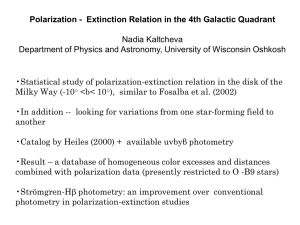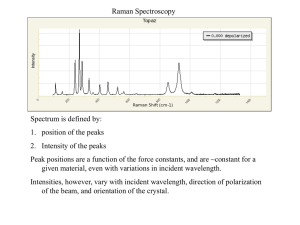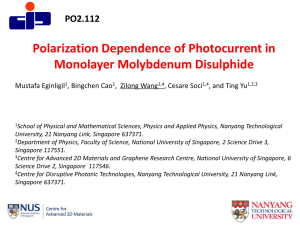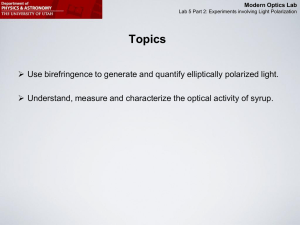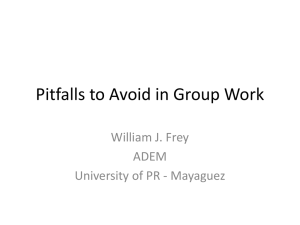Tracing CP-violation in low energy Lepton Flavor Violating processes
advertisement
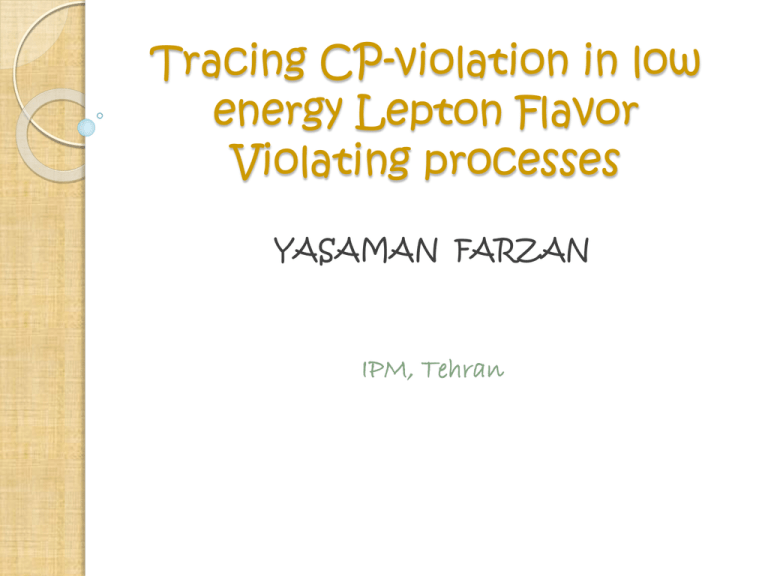
Tracing CP-violation in low energy Lepton Flavor Violating processes YASAMAN FARZAN IPM, Tehran This talk is based on Y. F., JHEP 0707 (07) 54 ; Ayazi and Farzan, JHEP 0901:022,2009; Y.F. , PLB677; Y.F. And Saereh Najjari, arXiv: 1001.3207 , to appear in PLB Plan of my talk LFV and CP in the SM and BSM Standard methods to search for LFV and CP-violation Tracing CP in LFV processes and Plan of my talk in general framework in R-parity Violating MSSM Feasibility of measurement Conclusions Flavor violation in the SM Reminder: but the famous CKM mixing or Or at one loop level to FCNC (observed) Flavor violation in lepton sector In the SM: We can go to a basis that the charged lepton mass matrix ( ) is diagonal. No mixing between flavors In the SM, LFV processes are strictly forbidden: NO NO NO ….. Neutrino oscillation Recent neutrino observation: Standard explanation: Neutrino mass and mixing where Neutrino oscillation The only evidence so far for physics BSM comes from observation of neutrino oscillation. Contribution of neutrino masses to LFV processes: Petcov Sov J. NP25; Bilenky et al, PLB67; Altarelli et al, NPB125 PDG Banerjee, hepex/0702017 Positive signal in future Physics BSM CP-violation in the SM The CKM mixing matrix contains one nonzero CPviolating phase. CP-violation: Jarlskog invariant CP-violation in the systems of K and B mesons has been observed and measured. CP-violation in the lepton sector Neutrino mass matrix contains one (or more) CPviolating phase. CP-violation in the neutrino mixing matrix: Superbeam Nu-factory EDM and MDM under CP CP: CP: MDM conserves CP but EDM violates CP. Present bound and prospects for improvement Present bound: [PDG] Near future: DeMille et al Foreseeable future: Lamoreaux, nucl-ex/0109014 (employing solid state techniques; Shapiro’s old idea) The phase of CKM: The phases of PMNS: de Gouvea, Gopalakrishna, PRD72 Positive signal New Physics Summary Detection of nonzero rate for LFV processes such as or conversion as well as nonzero electron EDM would indicates NEW PHYSICS BSM. Tantalizing hints for BSM Observational hints: 1) Dark matter 2) Deviation of 3) … Theoretical hints: 1) Hierarchy problem 2) Quest for unification from SM prediction Models predicting heavy states SUSY models Extra dimensions various Higgs models … All these models predict heavy particles to be directly produced at LHC…. Minimal Supersymmetric Standard Model (MSSM) arguably is the most popular one and is the focus of my talk. Limitations of LHC In general, the small LFV parameters of the MSSM cannot be measured by LHC. See however, kaneko et al., Measuring Lepton Flavor Violation at LHC with Long-Lived Slepton in the Coannihilation Region, PRD78. Limitations of LHC Suppose SUSY (or some other BSM) is discovered at LHC. Little or none can be learned about the the CP-violating phases in the lepton sector at LHC (see however, Godbole Czech J Physc 55; Heinemeyer and Velasco, hep-ph/0506267; Kittel, hep-ph/0504183 ). ILC Measuring CP-violation Low energy experiments Searches for EDMs can teach us about the CPviolating phases Degeneracy To solve degeneracies among the parameters of the underlying theory, any low energy experiment sensitive to CP-violating phases is welcome. Importance of CP-violation Sakharov’s conditions for dynamically creating the Baryon asymmetry of the universe Interplay of LFV and CPviolation Conventional wisdom as well as tradition say to look for LFV parameters we should focus on the LFV processes and to learn about the CP-violation we should study the EDMs. Can we learn about the CP-violation from LFV processes ? Synergies of EDM and LFV searches Can we derive information on CP-violation from ? Prospects of improvement Present bound: MEG experiment : (meg.web.psi.ch/index.html) First preliminary results: arXiv:0908.2594 If the present bound is saturated, MEG will have lots of data. Muons at MEG experiment are produced by decay of pions at rest so they are almost 100% polarized. Effective Lagrangian leading to =Polarization of the muon Parity violation in Angular distribution of positron relative to Discriminating between models Kuno and Okada, Rev. Mod. Phys. 73 (01) 151; Feng, hep-ph/0101122; Kuno and Okada, Phys Rev Lett77 (96) 434 Question Thus, the absolute values of be measured. and can CP CP Can we also measure their relative phase which violates CP? Polarization of final particles Y. F., JHEP 0707 (07) 54 Relative phase appears here Polarization of the final particles Summing over the polarization of the photon in , Summing over the polarization of the positron Correlation of spins of the final particles To extract information on the CP-violating phase, spins of the photon and positron have to be simultaneously measured. Ayazi and Farzan, JHEP 0901:022,2009 Maximal effect occurs at Practical point Established techniques to measure the transverse polarization of the emitted positron. Michel parameters Burkard et al., Phys Lett B 160 (85) 343. Measuring transverse polarization of photon at E=50 MeV ??? However, Bloser et al., astro-ph/0308331; Adamyan et al., NIMA 546 (05) 376. The conversion CP-violating phases from the polarization of the electron in the conversion: Davidson, arXiv:0809.0263; Ayazi and Farzan, JHEP 0901(2009) 22 Prospects of improvement Present bounds on conversion Bertl et al., Euro Phys J C 47 (06) 337. PRISM/PRIME experiment Kuno NPB (Pro. Suppl.) 149 (05) 376 NO technical limitation for improvement? Advantages and disadvantages Advantage of over No need for photon polarimeter. Disadvantage: At MEG, but at PRISM Evseev, in Muon Vol III Physics Chemistry and Solids, (1975) p. 236. : Muon Polarization in There are ways to re-polarize the muon. Nagamine and Yamazaki, Nucl Phys A 219 (74) 104; Kuno et al., Nucl. Phys. A 475 (87) 615. If bounds are saturated, PRISM/PRIME may collect lots of data. For our analysis we take Effective Lagrangian leading to conversion In principle, the effective terms of form can also contribute to conversion but in the context of R-parity conserving MSSM these terms are suppressed. Decay rate Conversion rate on nuclei of proton and neutron numbers of and : Hisano et al, PRD 53 (96) 2442 Extracting information Angular distribution of electrons , Let us define Can we also extract the relative phase of and ? Polarization Polarization of the final electron Ayazi and Farzan, JHEP 0901(09) 22 Maximal polarization: From General Beyond SM MSSM with R-parity R-Parity conserving MSSM Bounds on Bound on Assumptions We set bounds from to avoid the . We concentrate on the effects of and take them such that Ayazi and Farzan, JHEP 0901 (2009) 022 Reminder CP and LF conserving parameters: LHC Parameters entering LFV parameters: CP-violating phases: Phases of the above LFV parameters Set of observables Let us suppose LFV sources are large: MEG: , PRISM/PRIME: Let us suppose that and are measured and found to be in a favorable range: This means the transverse polarization is sizeable. Let us suppose and are measured and found to be nonzero. Can we solve the degeneracy? For example: Can we say is responsible for it? 0 rather than Colored points Black points: Experimental bound: Contrast : If new particles appear only in even numbers in each vertex, both processes can happen only at loop level: (e.g., R-parity conserving MSSM) Three body decay is suppressed by Toy model for three level Effective Lagrangian Under parity: Under CP: Energy distribution of the final particles Kuno and Okada, Rev Mod Phys 73 Angular distribution CP-violating phases Kuno and Okada, Rev Mod Phys 73 Other phases How about ?? Measuring the transverse polarization of the final particles Y.F. , PLB677 Muon versus anti-Muon Case of Polarization of Polarization of : : : Similar discussions apply to Case of : Polarization of : Polarization of : R-Parity violating MSSM Y.F. and Saereh Najjari, Extracting CP-violating phases of trilinear R-parity violating couplings from arXiv: 1001.3207 To appear in PLB R-Parity violating term One loop level correction De Gouvea et al. PRD63 A. De Gouvea et al., PRD63 Other bounds Baryogenesis Erasing Baryon asymmetry Barbier et al., Phys Rept 420 But CP-violating phases in the R-parity violating coupling can create their own Baryon asymmetry! e.g., see Masiero and Riotto, PLB 289 Observables Observables Transverse polarization of in Phases entering at tree level After rephasing the leptons, Input Explaining the oval shape For Keeping only For + and Technical issue in target Azimuthal distribution of the photons the positron. The transverse polarization of Moller scattering in target Azimuthal distribution of the final electrons The transverse polarization of the electron. Our paper, new version Conclusions By measuring the transverse polarizations of the emitted particles in the conversion and experiments, one can extract information on the CPviolating phases of the underlying theory. Information from complementary and experiments are Combining information from and can help us to solve the degeneracy of the parameters. Adding information from Electron EDM searches can be also helpful to reduce the degeneracy further. Conclusion The traverse polarization of the final particles in yield information on the CP-violating phases of the effective Lagrangian leading to these processes. R-parity violating MSSM: Degeneracy between Input from accelerators degeneracy and solving the

